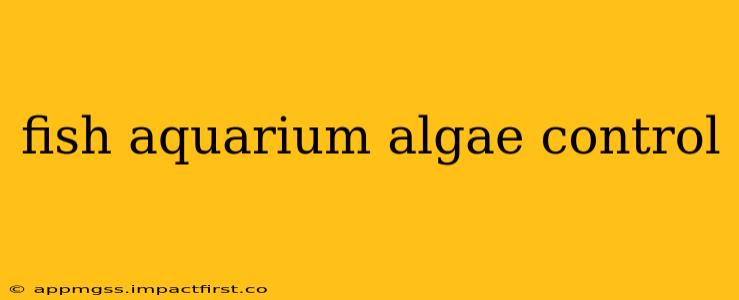Algae blooms in your fish aquarium can be frustrating, unsightly, and even harmful to your aquatic inhabitants. But don't despair! With the right knowledge and consistent effort, you can effectively control and prevent algae growth, maintaining a healthy and beautiful aquarium environment. This comprehensive guide will equip you with the tools and strategies to win the war against unwanted algae.
What Causes Algae in Fish Aquariums?
Algae thrive in environments with excess nutrients, particularly nitrates and phosphates. These nutrients enter the aquarium through several avenues:
- Overfeeding: Uneaten fish food decomposes, releasing excess nutrients into the water.
- Insufficient Water Changes: Regular water changes are crucial for removing accumulated waste and excess nutrients.
- Excessive Lighting: Too much light fuels algae growth.
- Poor Filtration: An inadequate filter system fails to remove sufficient waste products.
- High Levels of Organic Waste: Accumulated dead leaves, decaying plants, and other organic matter contribute to nutrient buildup.
How to Identify Different Types of Algae
Different algae species require different control strategies. Knowing what you're dealing with is the first step to effective treatment. Common aquarium algae include:
- Green Water: This is caused by free-floating algae in the water column, turning the water cloudy green.
- Hair Algae: Long, thin, black or brown strands that attach to surfaces.
- Brown Algae (Diatoms): A brownish film that appears early in a new tank's cycle.
- Green Spot Algae: Small, bright green spots on aquarium glass and decorations.
- Blue-Green Algae (Cyanobacteria): Often slimy and foul-smelling, this algae can be toxic to fish.
What are the Best Methods for Algae Control?
Addressing the root causes of algae growth is paramount. Here are several effective methods:
1. Regular Water Changes:
Performing partial water changes (25-50%) weekly is essential for removing accumulated waste and excess nutrients. This single action is often the most effective algae control measure.
2. Proper Feeding Habits:
Feed your fish only what they can consume within a few minutes. Avoid overfeeding, as leftover food is a major contributor to nutrient buildup.
3. Optimize Lighting:
Adjust your aquarium lighting schedule. Reduce the daily lighting duration, or choose lower intensity lighting to curb algae growth. Consider using a timer to maintain consistency.
4. Enhance Filtration:
Ensure your filter system is adequate for your tank size and fish population. Regularly clean or replace filter media as needed. Consider adding a phosphate remover to your filter system.
5. Manual Algae Removal:
For smaller amounts of algae, manual removal using an algae scraper for glass and a brush for decorations is an effective solution. Regularly removing algae before it becomes widespread prevents larger infestations.
How Can I Prevent Algae in My Aquarium?
Prevention is always better than cure. Implementing these preventative measures minimizes algae problems:
- Quarantine New Plants and Fish: New additions to your aquarium can introduce algae spores or increase nutrient levels. Quarantine them before introducing them to your main tank.
- Maintain a Balanced Ecosystem: A well-balanced ecosystem with enough beneficial bacteria will help process waste and reduce nutrient levels.
- Regular Maintenance: Consistent cleaning, water changes, and filter maintenance are key to preventing algae growth.
What are some natural ways to control algae in a fish tank?
Several natural methods can aid in algae control:
- Introducing Algae-Eating Fish: Certain fish species, such as Siamese Algae Eaters and Otocinclus Catfish, can help control algae populations. However, note that these fish may not completely eliminate algae, and overstocking can cause other issues.
- Using Aquatic Plants: Healthy plants compete with algae for nutrients, reducing their growth. Ensure you provide appropriate lighting and nutrients for plant growth.
Does UV Sterilizer Help Control Algae?
UV sterilizers can help control algae, particularly free-floating algae that cause green water. However, they don't address the underlying causes of algae growth, so they should be used in conjunction with other control measures.
How often should I clean my aquarium filter?
The frequency of filter cleaning depends on the type of filter media and the size of your tank. Generally, cleaning or replacing filter media every few months is recommended. Over-cleaning can disrupt the beneficial bacteria colony, so partial cleaning is often preferable.
By following these guidelines and tailoring your approach to the specific type of algae affecting your aquarium, you can effectively control algae growth and maintain a thriving, healthy environment for your fish. Remember, consistent effort and attention to detail are key to long-term success.
